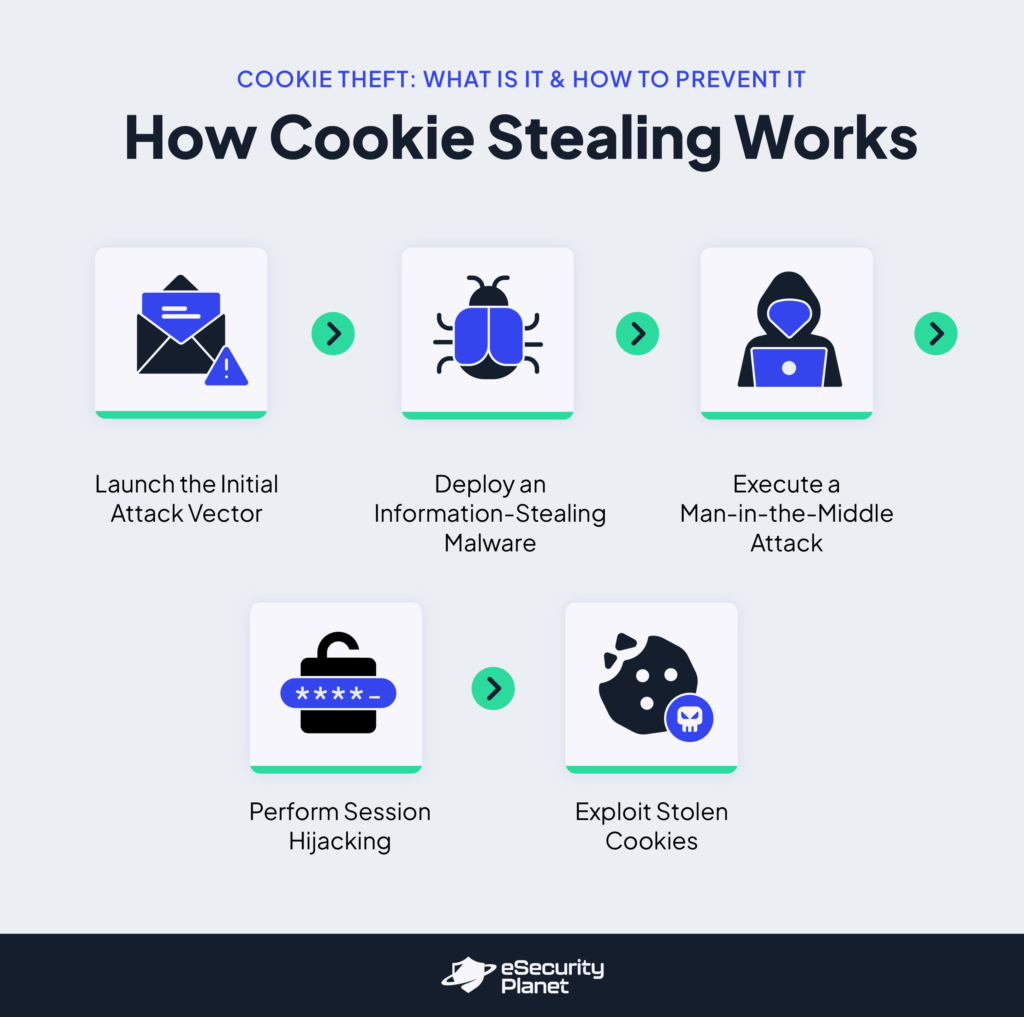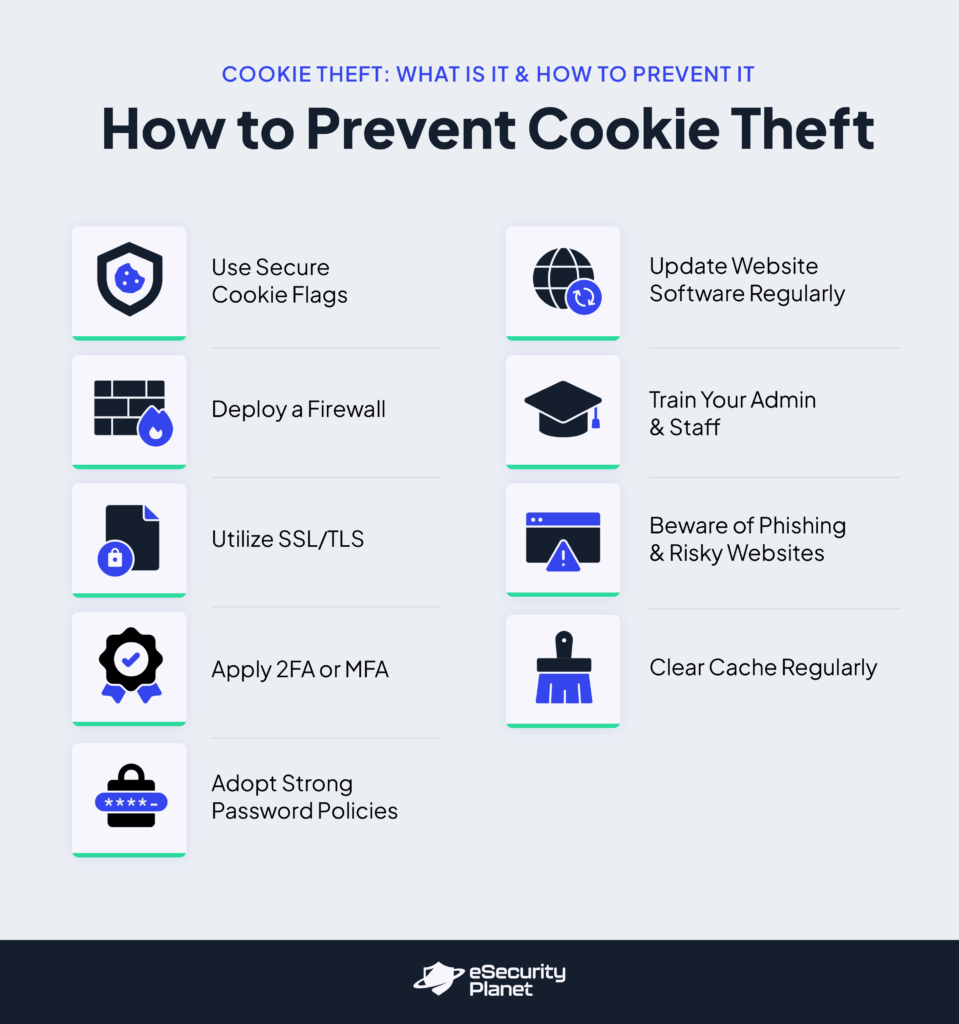Cookie theft is a type of cyberattack involving malicious actors exploiting cookies on a user’s device. These cookies save session data, including login credentials, which allows attackers to obtain unauthorized access to accounts. Although cookies are intended for secure session management, they require protection methods to avoid the risk of misuse and illegal access to personal information or online accounts.
How Does Cookie Stealing Work?
Attackers steal cookies through phishing, malware, and MITM attacks, resulting in data theft, financial loss, and identity theft. Understanding the implications, prevention, and recovery procedures can enhance the protection of your accounts and personal information. Long-term threats need a serious effort to secure stolen data and safeguard your privacy against further misuse.

1. Launch the Initial Attack Vector
Attackers will send you phishing emails or develop fake websites that appear legitimate, deceiving you into entering your login information. They may also use flaws in websites you visit to install malware on your device that extracts cookies from your browser. This enables attackers to access your accounts, exposing you to illegal access and data theft.
2. Deploy Information-Stealing Malware
Malicious actors deliver malware via phishing emails that you open or by exploiting software flaws. Once installed, the malware hits your browser, whether Chrome, Firefox, or Brave, and extracts cookies and sensitive data. Without your knowledge, this virus captures your session and personal information, placing you in danger of account takeovers and data breaches.
3. Execute a Man-in-the-Middle (MITM) Attack
While surfing on unprotected public Wi-Fi, cybercriminals intercept the communication between the browser you’re using and the website you’re on. Without encryption, they can monitor your connection and steal your session cookies, allowing them to hijack your accounts. This exposes you to fraudulent transactions and account misuse when doing sensitive tasks on public networks.
4. Perform Session Hijacking
Attackers may take over your active session by collecting session cookies if you remain logged in to sites or apps. Hackers may conceal dangerous malware in photos or links on insecure websites that you visit. When you click on these links, the code becomes active, allowing them to overcome your login processes, including multi-factor authentication, and potentially get unwanted access to your personal and financial information.
5. Exploit Stolen Cookies
After obtaining your cookies, attackers can sell them on dark web marketplaces or use them for other illegal activities. They may update your account settings, make illicit transactions, or install other types of malware on your device. You may face long-term implications, such as identity theft and financial loss, prompting lengthy efforts to safeguard your compromised accounts and personal information.
Risks & Implications of Cookie Theft
Cookie theft carries serious consequences, including identity theft, financial loss, and illegal access to accounts. Attackers use stolen cookies to conduct unlawful transactions, violate privacy, and harm reputations. The repercussions can be difficult to discover and recover from, resulting in long-term consequences such as legal challenges, productivity loss, and continued exploitation of sensitive data.
Identity Theft
Identity theft happens when attackers utilize stolen cookies to obtain personal information such as names, addresses, or financial information. With this information, they can impersonate you, open credit accounts, and engage in fraudulent activities. The long-term consequences include destroyed credit, financial loss, and the significant time and effort required to recover your identity.
Financial Loss
Hackers can use stolen cookies to gain access to your financial accounts, make fraudulent transactions, or transfer funds. This might result in sudden financial losses, depleted bank accounts, and maxed-out credit cards. Recovering these funds can be difficult, and you may encounter legal or financial issues as a result.
Unauthorized Access
Once attackers hijack your cookies, they have illegal access to your online accounts. This can comprise personal, financial, or professional accounts that can access, alter, or remove sensitive data. Violating privacy and control over your accounts might result in substantial data loss or misuse.
Illegal Transactions
Stolen cookies allow attackers to carry out illegal activities, such as making purchases, transferring money, or changing account information. These activities can cause immediate financial harm, disturb your financial management, and result in disputes with financial institutions, thereby lowering your credit score.
Loss of Privacy
Attackers who gain access to your cookies may expose personal information such as browsing history, messages, and login information. This violation of privacy may reveal vital information, leaving you open to future assaults or exploitation. The loss of privacy can cause personal and emotional pain.
Damage to Your Reputation
If attackers exploit your stolen cookies to assume your identity online, they might release improper content or engage in fraudulent activity in your name. This can harm your personal or professional reputation, resulting in loss of trust, social ramifications, and possible career consequences.
Legal Consequences
Businesses that neglect to secure user cookies may face legal consequences if they are stolen and result in data breaches. The potential legal implications can include fines, lawsuits, and compliance. If the stolen identity is used for illegal activities, it may also lead to legal complications for that individual.
Productivity Loss
Dealing with the aftermath of cookie theft takes a significant amount of time and work, whether you’re regaining access to accounts or dealing with security breaches. This decrease in productivity may interfere with your everyday activities, cause stress, and result in missed opportunities or delayed tasks.
Vulnerability of Sensitive Data
Cookies frequently hold sensitive data, such as login credentials and personal information. If this data is stolen, it becomes vulnerable to misuse by hackers, potentially leading to more exploitation, illegal access to other accounts, and worse security breaches.
Difficulty in Detection
Cookie theft is often difficult to detect because attackers can operate without leaving visible evidence. The lapse in detection enables attackers to continue exploiting your accounts or data, causing more extensive damage before you’re even aware of the breach.
How Do You Know If You’re Being Targeted?
Early detection of cookie theft helps protect your online accounts and personal information. Understanding the subtle signs of compromised cookies can help you take quick action to secure your network and data further or avoid identity theft and financial implications.
You may be a victim of cookie theft if you:
- Detect suspicious account activity: Look for unauthorized logins, posts, or transactions on your online profiles that you did not initiate.
- Receive unexpected password reset notifications: Identify unrequested password reset messages as potential evidence of exploited access.
- Discover unforeseen changes to settings: See if your email addresses, phone numbers, or credentials have been changed without your permission.
- Experience repeated logouts: Observe if you’re constantly and abruptly getting logged out of an account, as it may be a sign of session hijacking.
- Get unusual login notifications: Look for alerts regarding logins from unknown devices or places, which could indicate unwanted access.
- Spot strange network traffic: Monitor unexpected data transfers or connections to unknown servers, which may indicate cookie-related compromises.
- Observe random browser behavior: Notice if your browser redirects to suspicious sites or behaves weirdly. This could indicate unwanted interference.
- Receive security software alerts: Inspect any antivirus or security software alerts regarding detected network threats or suspicious activities in your browser.
- Notice increased spam or phishing messages: Examine if there’s a surge in spam or phishing attempts that could be targeting accounts via stolen cookies.
- Find unidentified devices in security logs: Look for new devices in your account’s security settings that you don’t recognize, which could indicate unauthorized access.
9 Ways to Prevent Cookie Stealing
Implement critical security measures such as establishing secure cookie flags, implementing SSL/TLS for encrypted sessions, and deploying strong firewalls. Enhance account security using Two-Factor Authentication (2FA), enforce strong password restrictions, and regularly update software to protect against possible threats.

Use Secure Cookie Flags
Configure cookies using security options like Secure and HttpOnly. The Secure option ensures that cookies are exclusively transferred via HTTPS, whereas the HttpOnly flag prohibits cookies from being accessible by client-side scripts. This lowers the chance of cookies being taken via unencrypted connections or cross-site scripting (XSS) attacks.
Deploy a Firewall
Install a reliable firewall to prevent malicious communications and safeguard against exploitation. Firewalls monitor incoming traffic, flag questionable requests, and enforce security policies to prevent unwanted access and session hijacking attempts. This protects your website from potential cookie theft threats and improves overall security.
Utilize SSL/TLS
Secure your website with HTTPS by using SSL/TLS certificates to encrypt data sent between users and servers. Encryption makes it nearly impossible for attackers to intercept and steal session cookies, keeping critical information safe during transmission and improving overall data security.
Apply 2FA or MFA
Increase account security by using two-factor authentication (2FA) or multi-factor authentication (MFA). While cookie theft may bypass MFA, this extra verification step can still provide significant protection. Requiring a second form of authentication in addition to passwords makes it far more difficult for attackers to access accounts, even if session cookies are compromised.
Adopt Strong Password Policies
Encourage the use of strong, unique passwords and implement standards for regular password upgrades. Enforcing complexity criteria and making regular adjustments lessens the risk of password breaches and the chance of attackers using stolen cookies to gain unauthorized access.
Update Website Software Regularly
Keep your website’s WordPress, themes, and plugins up to date. Regular updates fix security flaws that could be used to steal cookies. By installing the most recent updates and security fixes, you lessen the likelihood of attackers exploiting outdated programs to compromise session cookies.
Train Your Admin & Staff
Educate admin and other personnel on the dangers of session hijacking and the effective practices for prevention. Ensuring that they learn secure practices and recognize potential threats reduces risks. It also encourages the organization’s culture of adhering to security measures to prevent cookie theft and other common security risks.
Beware of Phishing & Risky Websites
Stay alert for phishing attempts and avoid dangerous websites. Phishing scams and rogue websites can spread cookie-stealing software. Examine emails, texts, and site links thoroughly to avoid unintentional exposure to cookie theft and other cyber risks.
Clear Cache Regularly
Make it a practice to clear your browser’s cache and cookies periodically. This method helps to erase any potentially compromised cookies and reduces the impact of cookie theft. Regular cache emptying prevents malware impact and ensures that it has fewer resources to exploit even if it exists.
How to Recover from Cookie Theft
To recover from cookie theft, website administrators should do a security scan with a program to delete any detected risks. Then, invalidate active sessions, update passwords and security keys, and then refresh the website software. End users should change their passwords, clean their browser cache, enable two-factor authentication, monitor their accounts, and update their security settings.
Recovery Methods for Website Admins
Website administrators should apply these recovery techniques to manage and resolve cookie theft concerns successfully:
- Run a security scan: Use a reliable security tool like antivirus to scan your website thoroughly. Examine the scan results to detect and pinpoint any harmful code or vulnerabilities.
- Get rid of malicious codes: Utilize your security plugin or malware removal program to quarantine or delete any discovered risks. Run another scan to confirm complete removal, then update your security settings to avoid future infections.
- Disable active sessions: Go into your admin dashboard and log out all active users. The process invalidates stolen cookies and prevents unwanted access. Inform users that they must log in again using their changed credentials.
- Configure authentication credentials: Change all user and admin passwords. Review the WordPress salts and security keys in the wp-config file to remove all existing sessions and require users to log in again.
- Refresh website software: Verify and deploy updates to all plugins, themes, and core software. Ensure that all updates are properly installed to fix security vulnerabilities and guard against future attacks.
Recovery Methods for End Users
End users should follow these measures to secure their accounts and reduce the possibility of cookie theft:
- Update passwords: For all affected accounts, replace the passwords immediately. To prevent future illegal access, use a password manager to create strong, unique passwords.
- Clear browser cache: To remove possibly compromised cookies and cached data, clear your browser’s cache and cookies. This step helps to remove any residual session data.
- Activate two-factor authentication (2FA): Turn on 2FA on your accounts to offer an extra degree of security. Configure 2FA in your account’s security settings to make illegal access more difficult.
- Keep track of account activity: Check your account activity regularly for any indications of unusual conduct or fraudulent activities. Report any odd activities to the service provider right at once.
- Adjust security settings: Review and improve your account’s security settings. Confirm that security measures such as security questions and email verification are up to date and correctly configured.
Frequently Asked Questions (FAQ)
What Are the 2 Types of Cookies?
Cookies are classified into two types: session cookies, which disappear when the browser is closed and are used for session activities; and persistent cookies, which remain on the device after the browser is closed and save data such as login credentials and site preferences for future visits.
How Do Cookies Track You?
Cookies track users by assigning them a unique identification that’s kept in the cookie. First-party cookies store user-specific information for a single site, whereas third-party cookies track activity across several sites. This enables individualized experiences and larger online behavior tracking, which is commonly used for targeted advertising and analyzing user habits.
Can Cookies Steal Passwords?
Cookies can’t steal passwords; nonetheless, they can be hijacked. In attacks such as session hijacking, hackers use cookies to get access to sensitive data, including passwords. Once they obtain this information, criminals can potentially steal money or compromise online accounts, thus, it’s critical to protect cookies from unwanted access.
Bottom Line: Mitigate the Risks of Cookie Theft
Cookies track and collect information, causing privacy concerns. Cookie theft can jeopardize your online security, and recovery might be difficult once it occurs. To avoid potential headaches dealing with cookie theft, prioritize prevention. Enhance network security by employing strong passwords, strengthening authentication methods, and keeping your software updated and monitored.
Preventing cookie theft is a critical part of network security, but additional measures should also be applied for your comprehensive protection. Explore our detailed guidelines on how to secure a network to learn more about effective network protection.
Julien Maury contributed to this article.




